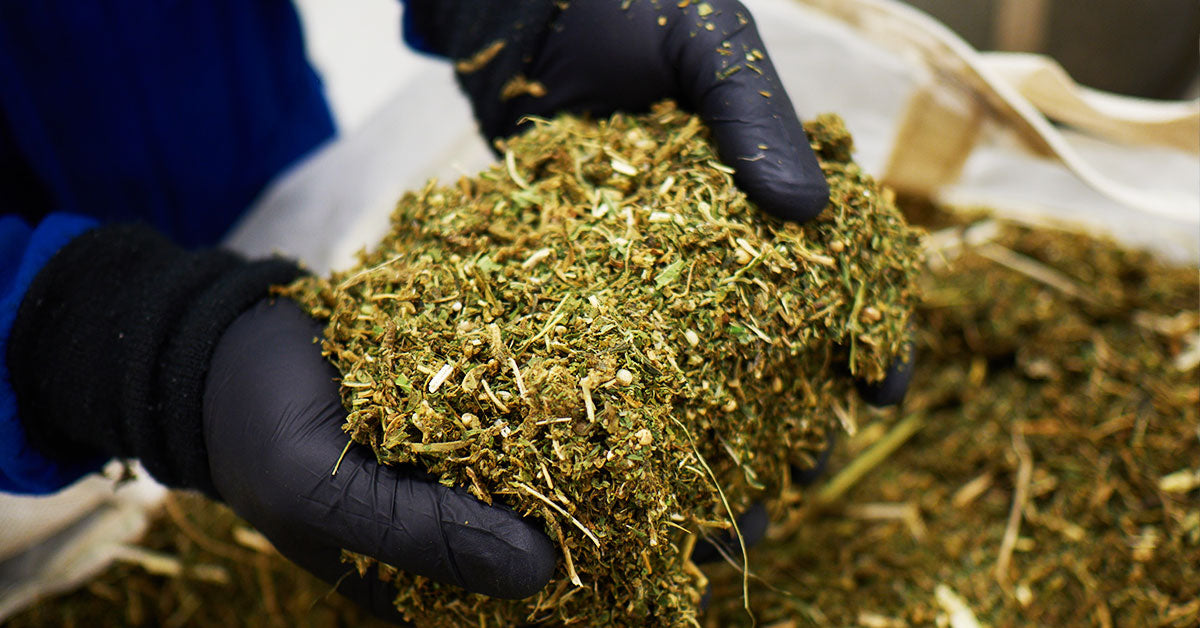
At Lazarus Naturals we grow, harvest, and extract all of our hemp at our farm in Powell Butte, Oregon. Our farm team harvests the organically grown hemp from the fields and stages it for extraction by drying, packaging, and storing it away from light and the elements in a facility onsite. The hemp plant is composed of several hundred discreet compounds; the specific active compounds of interest are cannabinoids, namely cannabidiol (CBD), and terpenes. Cannabinoid and terpene concentrations vary from plant to plant; the female plant flowers contain the highest concentration of cannabinoids. The express purpose of the cannabis extraction process is to separate these active compounds from the rest of the plant material (plant matter comprised of stems, leaves, and some dirt) in order to refine and concentrate into full-spectrum oil, broad spectrum oil, and isolate prior to adding them to a variety of consumable products such as CBD tinctures, CBD topicals, CBD pills and CBD edibles. From a manufacturing perspective, extraction is the first processing step that separates these active compounds from the raw hemp plant we need for CBD oil.
Every step of our plant extraction process is certified organic and designed to keep material resource waste at a minimum in our ongoing commitment to sustainable practices. Ethanol is plant-derived and thus can be certified organic; many other hemp plant solvent options are synthetic or difficult to procure organically. There are numerous extraction methods, but ethanol is the ideal solvent for extracting hemp at our production scale, especially when factoring in safety, associated equipment and process scalability, and cost. Furthermore, the polarity of ethanol can be somewhat modulated by temperature. When chilled to -40° C, ethanol has a higher affinity for non-polar fat-soluble compounds (i.e., cannabinoids and terpenes) and a lower affinity for polar water-soluble compounds such as chlorophyll and plant proteins and sugars. For these reasons, Lazarus Naturals uses an ethanol extraction process to create our hemp plant products.
Ethanol extraction is a process in which plant matter is immersed in chilled ethanol within a closed-loop centrifugation system, dissolving the target compounds into the extract solution and leaving most of the unwanted compounds behind with the biomass. After ethanol extraction is complete, a series of filtration steps are applied to remove plant particulate, lipids, and waxes after which all traceable amounts of ethanol are evaporated from the extract, leaving a full-spectrum oil consisting of cannabinoids—predominantly CBD, and to a lesser extent other phytocannabinoids cannabinoids such as THC, CBG, CBN—and terpenes. This oil can then be concentrated by various distillation and isolation methods, which increase the cannabinoid potency (i.e., more cannabinoid per milliliter), and then added to various product formulations.
Our Research & Development team is constantly investigating newer, better, and more innovative ways to produce the cleanest, highest quality CBD oil for the people who need it the most. We’re as meticulous in the treatment of the raw biomass brought to our extraction facilities as our teams out in the fields have been with the millions of plants they have grown from the ground up.
Why Is Cold Ethanol Extraction the Safest Option For CBD Oil?
According to the FDA, cold ethanol extraction is one of the safest methods for pharmaceutical and food grade processes. Using an ethanol extraction system is the safest option because it effectively removes botanical compounds from plant matter. This extraction solvent works by binding to cannabinoids and other beneficial botanical compounds that are found in the cannabis plant.
If you're ready to take advantage of everything CBD oil has to offer, now is the perfect time to get started. Shop our wide selection of CBD oil products today to support your health and wellbeing like never before.
Very educational. Thank you.
That’s why I recommend your products to anyone that questions me. Lazarus Naturals is on the up and up about the whole process and gives an explanation from start to finish. Thanks for your products.
This is important information because so many people are misled into believing ethanol is somehow related to fossil fuel gasoline byproducts and leaves a residue when used to extractions in cannabis. You have put that fear to rest. Thanks for Passing it on.
I studied and researched chlorophyll synthesis in grad school. We had some pretty complex extraction processing for the light adsorbing compounds but nothing like your description or the scale. Interesting.
I’m sold on small enterprizes specially if there family owed-hope ther will a next generation to keep it going-because of your military discount , I can afford your products-God bless and have a good day.